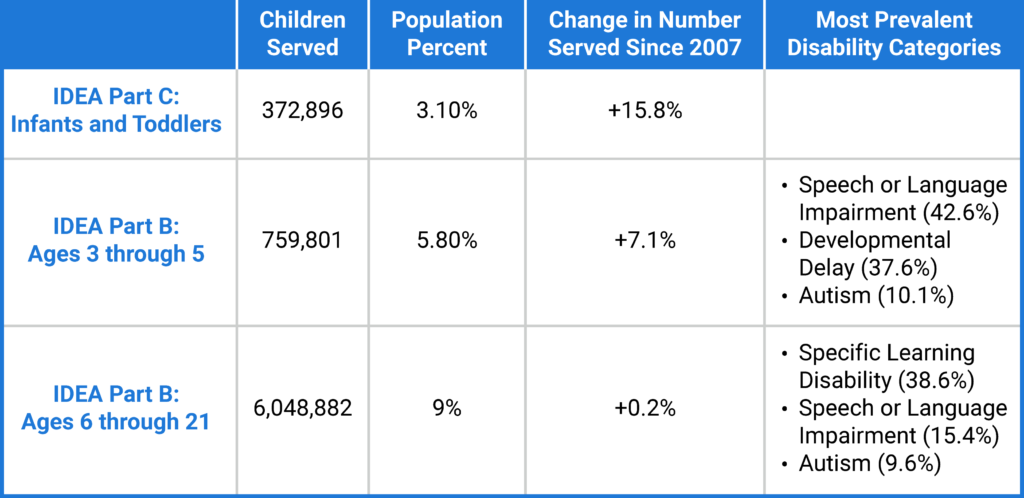A Quick Guide to Individual Education Plans (IEPs)

“Our task is to help children communicate with the world using all their potential, strengths, and languages and to overcome any obstacle presented by our culture.” – Loris Malaguzzi
The Individuals with Disabilities Education Act
The Individuals with Disabilities Education Act (IDEA) was signed into law in 1975 to define and mandate a free and appropriate public education (FAPE) to eligible children with disabilities. The IDEA statute is comprised of four parts, with each part covering a different aspect of the law. For most families, Parts B and C are the most important to understand.
Part A: General Provisions
This section outlines the general provisions and terminology used throughout the law.
Part B: Assistance for All Children with Disabilities
This section requires schools to provide special education services to children and youth with disabilities from ages 3 through 21.
- An Individualized Education Program (IEP) is developed to document the needs, goals, and services provided.
- A case manager is designated to monitor the plan for each student.
- Services are typically provided during the school year in a classroom setting.
- IEPs are reviewed annually.
Part C: Infants and Toddlers with Disabilities
This section requires states to provide early intervention services to infants and toddlers (from birth to age 2) with disabilities and their families.
- An Individualized Family Service Plan (IFSP) is developed to document the needs, goals, and services provided.
- Services are provided year-round in the child’s natural environments (home or other community settings).
- A service coordinator is assigned to ensure the plan is implemented correctly between providers.
IFSPs are reviewed every six months. - The IEP team must determine whether the child is eligible for services under Part B by the child’s third birthday.
Part D: National Activities to Improve Education of Children with Disabilities
This section includes provisions related to discretionary grants to support development of qualified personnel, professional development, technical assistance, and parent training.
Who Serves on an IFSP or IEP Team?
IFSPs and IEPs are written statements developed by a team of administrators, educators, and other professionals in collaboration with children and their families. Members of both the IFSP and IEP teams may be asked to provide direct or consultative services to help young children and students with disabilities meet their goals.
Special education team members may include:
- The child (when appropriate)
- Parents and/or caregivers
- Teachers (general education and special education)
- A representative of the school system, such as the principal
- A speech-language pathologist
- An occupational therapist and/or certified occupational therapy assistant
- A physical therapist and/or physical therapy assistant
- A psychologist
- A social worker
- An interpreter (when appropriate)
Eligibility Criteria
Under Part B of IDEA, there are thirteen different disability categories. A child can receive special education and related services if they are found eligible under any of the categories; however, each disability category has its own set of eligibility criteria.
The categories recognized under Part B of IDEA include:
- Autism spectrum disorder (ASD)
- Deaf-blindness
- Developmental delay
- Emotional disability
- Hearing impairment
- Intellectual disability
- Multiple disabilities
- Orthopedic impairment
- Other health impairment
- Specific learning disability
- Speech-language impairment
- Traumatic brain injury
- Visual impairment
Part C of IDEA contains one disability category, developmental delays. A child is eligible for services if they:
- Have a developmental delay (cognitive, physical, communication, social-emotional, etc.)
- Have a confirmed diagnosis of a condition with a high probability of developmental delay
- Are considered “at-risk” infants or toddlers
Program Implementation
The 40th Annual Report to Congress on the Implementation of the IDEA (2018) describes progress made toward providing a FAPE to infants, children, and youth with disabilities in the United States. The report contains data obtained from the U.S. Department of Education’s EDFacts Data Warehouse (EDW) and Office of Special Education Programs (OSEP).
A summary of select data from 2016 is provided below.

It is important to note that IDEA governs how states and public agencies provide special education and related services to eligible infants, children, and youth. Not every child with a disability will qualify for special education and related services. Ultimately, the child’s individual needs will determine what services they receive.
- U.S. Department of Education. (2018). 40th Annual Report to Congress on the Implementation of the Individuals with Disabilities Education Act, 2018.
- U.S. Department of Education. (n.d.). Statute and Regulations. Retrieved from https://sites.ed.gov/idea/statuteregulations/

